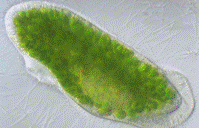Papers in the Biological Sciences
Document Type
Article
Date of this Version
2023
Citation
Published in Microbial Ecology, 2023
doi:10.1007/s00248-023-02292-w
Abstract
Chemotaxis is widespread across many taxa and often aids resource acquisition or predator avoidance. Species interactions can modify the degree of movement facilitated by chemotaxis. In this study, we investigated the influence of symbionts on Paramecium bursaria’s chemotactic behavior toward chloroviruses. To achieve this, we performed choice experiments using chlorovirus and control candidate attractors (virus stabilization buffer and pond water). We quantified the movement of Paramecia grown with or without algal and viral symbionts toward each attractor. All Paramecia showed some chemotaxis toward viruses, but cells without algae and viruses showed the most movement toward viruses. Thus, the endosymbiotic algae (zoochlorellae) appeared to alter the movement of Paramecia toward chloroviruses, but it was not clear that ectosymbiotic viruses (chlorovirus) also had this effect. The change in behavior was consistent with a change in swimming speed, but a change in attraction remains possible. The potential costs and benefits of chemotactic movement toward chloroviruses for either the Paramecia hosts or its symbionts remain unclear.


Comments
Copyright © 2023 Ho et al., under exclusive license to Springer Science+Business Media, LLC, part of Springer Nature. Used by permission.